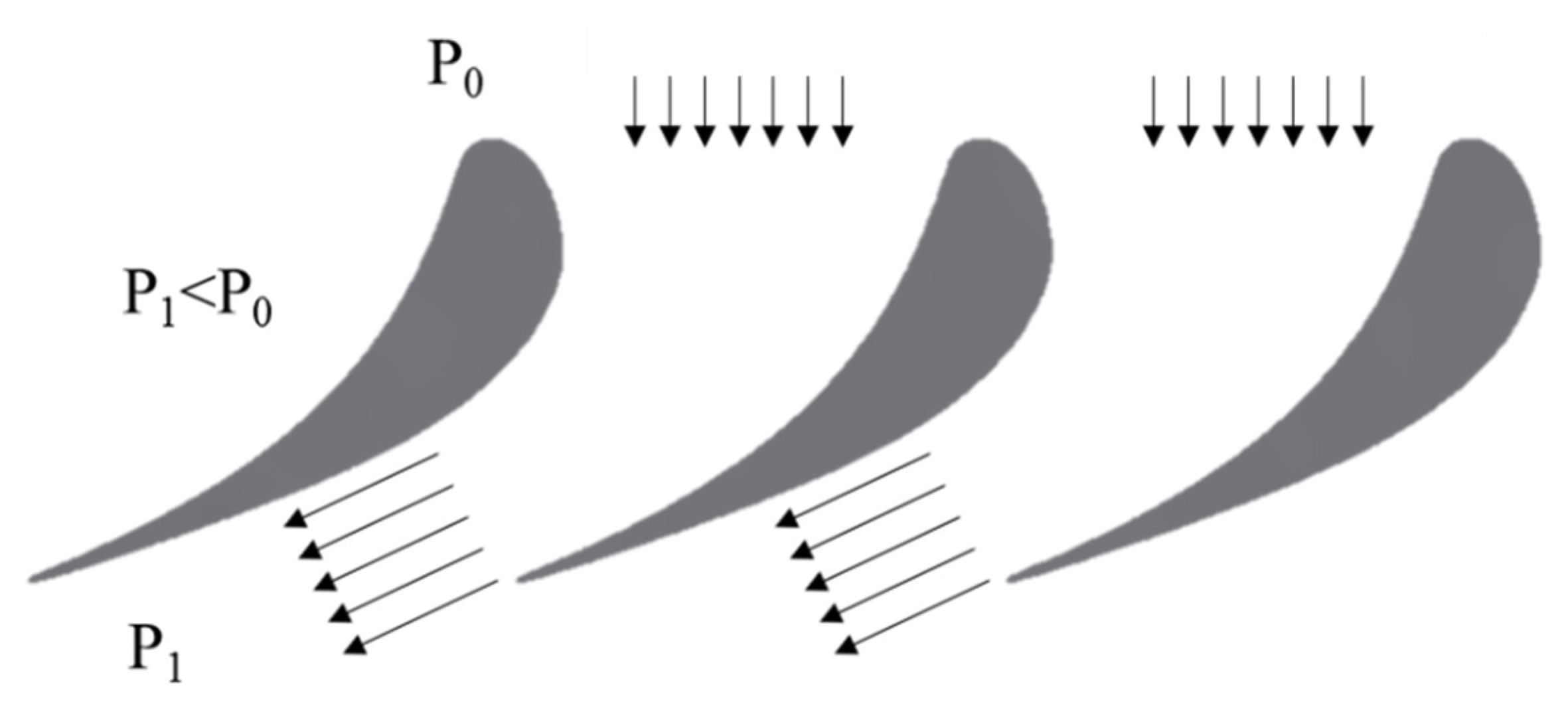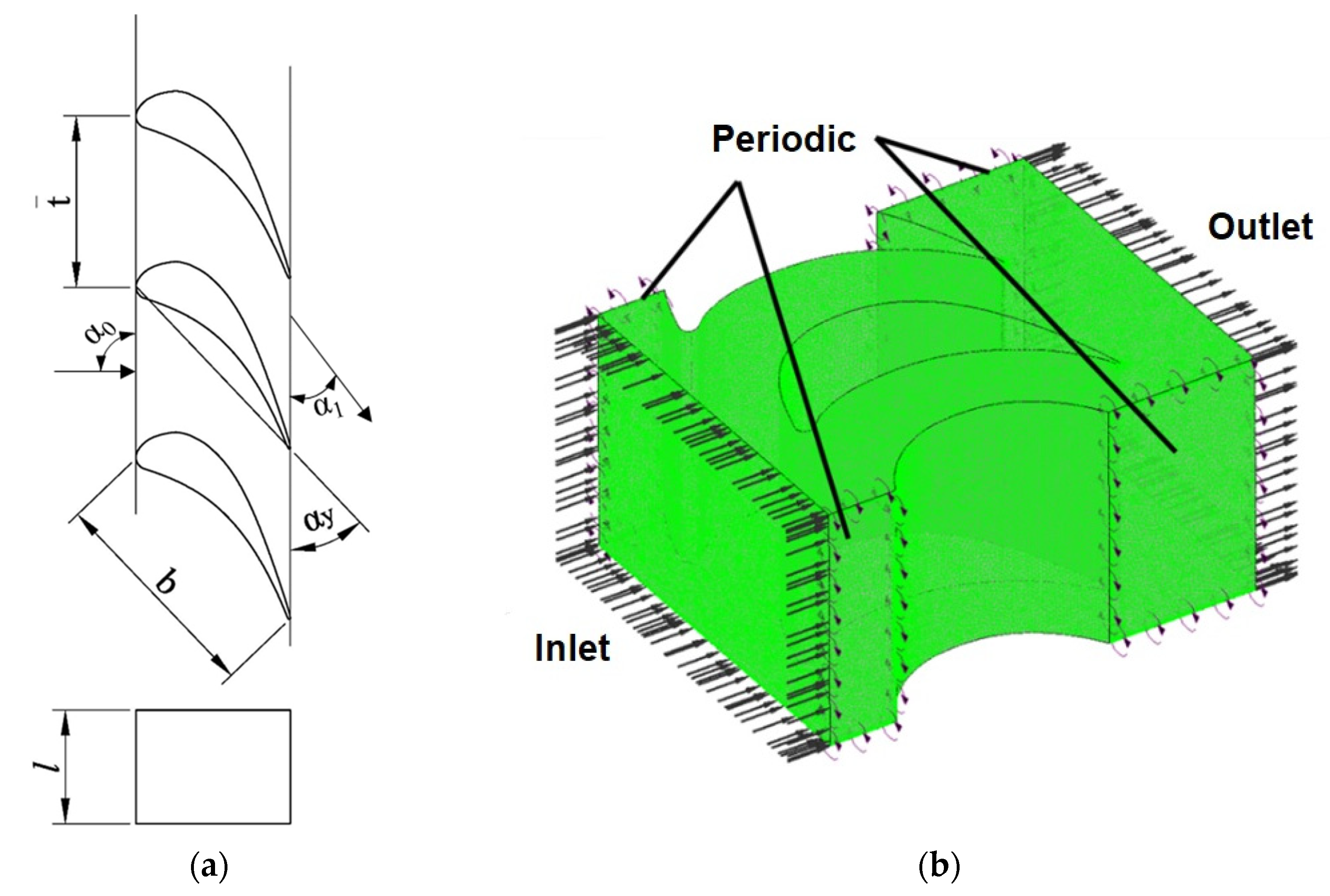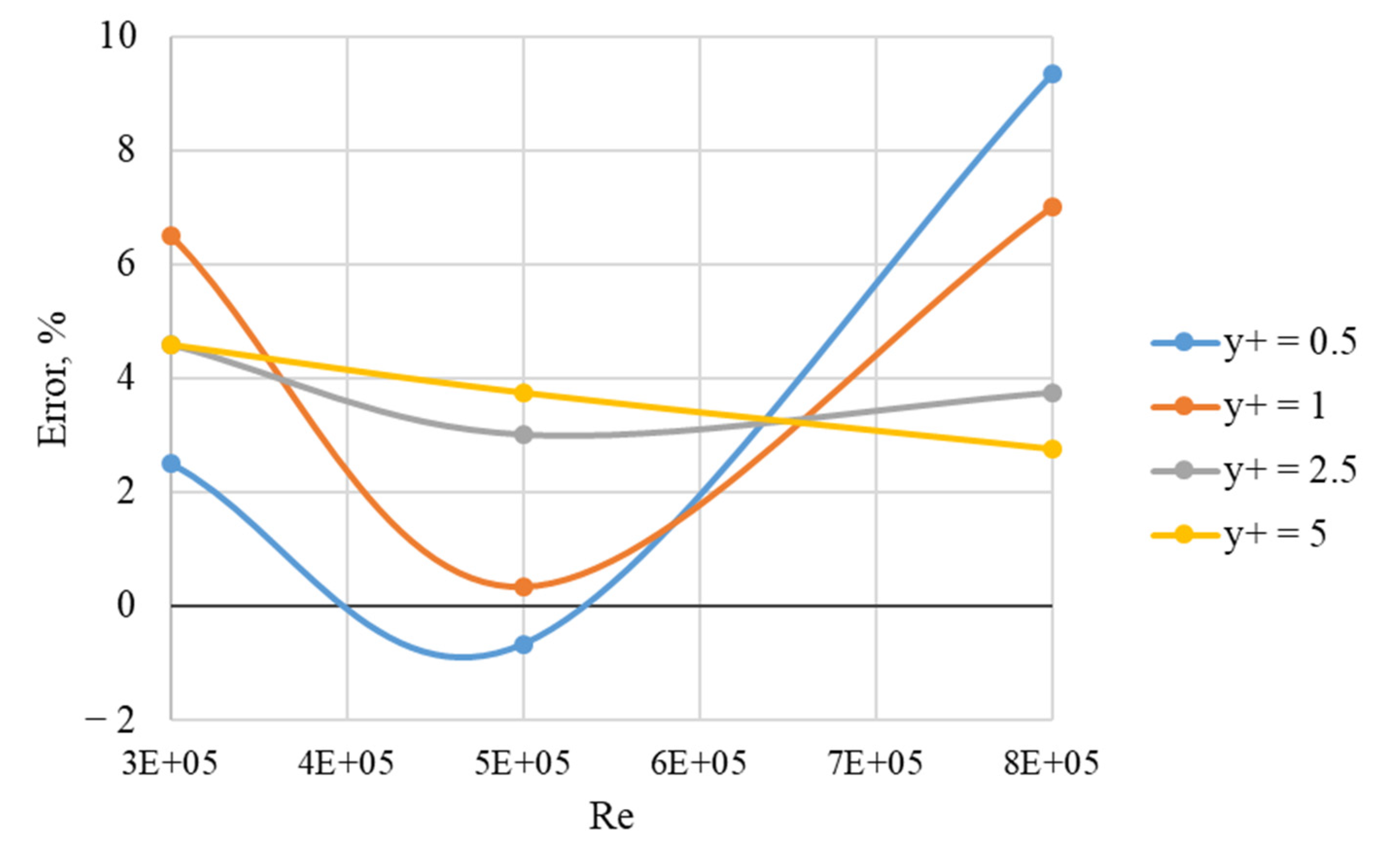Computer Flow Simulation and Verification for Turbine Blade Channel Formed by the C-90-22 A Profile
Abstract
:1. Introduction
- is the dimensionless height;
- D is the characteristic size, m;
- Re is the Reynolds number.
- y is a dimensional coordinate, m;
- is the shear velocity, m/s;
- is the kinematic viscosity, m2/s.
- for high-Reynolds models, which use near-wall functions (k − ε), it is recommended to take y+ exceeding 30 due to the need to place the first near-wall cell outside the viscous boundary layer.
- the choice of low-Reynolds SST or k − ω turbulence models;
- the choice of low values of y+ not exceeding 1;
- the choice of a computational grid that provides the number of control volumes within the range of 500,000 to 1,500,000 elements.
2. Research Object
- (1)
- profiled ones:
- -
- friction losses: these are directly related to the formation of a boundary layer on the concave and convex parts of a profile and its interaction with the main flow [14];
- -
- edge losses: these are related to the convergence of flows with different velocities behind the trailing edge [15];
- -
- wave losses: these occur only in supersonic flows; when the Mach number is greater than the critical value, a supersonic region is formed on the blade surface ending with shock waves [16];
- (2)
- -
- the profile chord length b: it is selected based on the blade strength conditions;
- -
- the ratio of profile chord length to blade height b/l; blades with a relatively large value of b/l are installed mainly in the first stages of turbines, and vice versa for the last stages;
- -
- the relative setting pitch : it has its own optimal value for each profile which is determined by the empirical formula by V.I. Dyshlevsky [11];
- -
- the profile installation angle αy: it depends on the value of the effective angle of the flow entry into the array and is determined by a semi-empirical formula.
3. Research Method
3.1. Description of the Computational Grid Parameters
3.2. Description of the Solver Settings and Boundary Conditions
- is the term of production;
- —wall distance;
- —density;
- —dynamic viscosity;
- —eddy viscosity;
- —kinetic eddy energy;
- —specific dissipation rate.
- —density;
- —dynamic viscosity;
- —eddy viscosity;
- —kinetic eddy energy;
- —specific dissipation rate;
- u—velocity.
4. Results and Discussion
- —mass flow averaged static pressure on outlet, Pa;
- —mass flow averaged total pressure at the entrance to blade channel, Pa;
- —mass flow averaged total pressure at the exit blade channel, Pa
- —specific heats ratio, 1.4 for air.
- —experimental values of pressure loss coefficient [11];
- —value of pressure loss coefficient, obtained from numerical simulation.
5. Conclusions
- the application of the k − ω turbulence model provides an acceptable deviation from the experimental data within {−10%, +10%} only within a limited range of Re, which suggests that this model is not recommended for solving the problems of the considered class;
- the SST turbulence model provides an acceptable deviation from the experimental data within the entire considered range of Re (300,000 to 800,000); in this case, the error for various values of parameter y+ varies insignificantly; the deviation of the curves from each other does not exceed a few percent;
- there is no single type of dependence of the computer simulation errors on the Reynolds number for various geometric configurations; there is also no single type of relationship between different values of y+ within the recommended range of one to five and the computer solution error;
- nevertheless, according to research results, it is possible to track trends in changing the values of y+ corresponding the minimal error values for different Re: with an increase in Re, in general, the value corresponding to the minimum error increases.
- for considered blade channel with aspect ratio b/l = 2 the values of y+ with the best concurrence with experimental data is following: y+ = 0.5 for Re 300,000, y+ = 1 for Re 500,000 and y+ = 5 for Re 800,000.
- for considered blade channel with aspect ratio b/l = 1 the values of y+ with the best concurrence with experimental data is following: y+ = 0.5 for Re 300,000, y+ = 2.5 for Re 500,000 and y+ = 2.5 for Re 800,000.
Author Contributions
Funding
Institutional Review Board Statement
Informed Consent Statement
Data Availability Statement
Conflicts of Interest
References
- Chorin, J. Computer solution of the Navier-Stokes equations. Math. Comput. 1968, 22, 745–762. [Google Scholar] [CrossRef]
- Argyropoulos, D.; Markatos, N.C. Recent advances on the computer modelling of turbulent flows. Appl. Math. Model. 2015, 39, 693–732. [Google Scholar] [CrossRef]
- Yang, L.; Zhang, G. Analysis of Influence of Different Parameters on Computer Simulation of NACA0012 Incompressible External Flow Field under High Reynolds Numbers. Appl. Sci. 2022, 12, 416. [Google Scholar] [CrossRef]
- Nagib, H.M.; Chauhan, K.A.; Monkewitz, P.A. Approach to an asymptotic state for zero pressure gradient turbulent boundary layers. Philos. Trans. R. Soc. Math. Phys. Eng. Sci. 2007, 365, 755–770. [Google Scholar] [CrossRef] [PubMed]
- Kindra, V.O.; Rogalev, A.N.; Osipov, S.K.; Zlyvko, O.V.; Vegera, A.N. Computer study of flow and heat transfer in a rectangular channel with pin fin arrays and back ribs. In Proceedings of the European Conference on Turbomachinery Fluid Dynamics and Thermodynamics, Gdansk, Poland, 12–16 April 2021. [Google Scholar]
- Jiménez, J. Coherent structures in wall-bounded turbulence. J. Fluid Mech. 2018, 842, 1. [Google Scholar] [CrossRef]
- Popov, G.; Matveev, V.; Baturin, O.; Novikova, Y.; Volkov, A. Selection of Parameters for Blade-to-blade Finite-volume Mesh for CFD Simulation of Axial Turbines. MATEC Web Conf. 2018, 30, 3. [Google Scholar] [CrossRef]
- Zaryankin, A.; Rogalev, A.; Kindra, V.; Khudyakova, V.; Bychkov, N. Reduction methods of secondary flow losses in stator blades: Computer and experimental study. In Proceedings of the European Conference on Turbomachinery Fluid Dynamics and thermodynamics, Stockholm, Sweden, 3–7 April 2017. [Google Scholar]
- Sun, S.; Wu, X.; Huang, Z.; Hu, X.; Zhang, P.; Kong, Q. Experimental and computer investigation of periodic downstream potential flow on the behavior of boundary layer of high-lift low-pressure turbine blade. Aerosp. Sci. Technol. 2022, 123, 1. [Google Scholar] [CrossRef]
- Deych, M.E.; Filippov, G.A.; Lazarev, L.Y. Atlas Profiley Reshetok Osevykh Turbin; Mashinostroenie: Moscow, Russia, 1965. [Google Scholar]
- Loytsyanskiy, L.G. Mehanika Zhidkostey i Gazov; Nauka: Moscow, Russia, 1987. [Google Scholar]
- Zhao, W.; Hu, J.; Wang, K. Influence of Channel-Diffuser Blades on Energy Performance of a Three-Stage Centrifugal Pump. Symmetry 2021, 13, 277. [Google Scholar] [CrossRef]
- Giovannini, M.; Rubechini, F.; Marconcini, M.; Arnone, A.; Bertini, F. Reducing Secondary Flow Losses in Low-Pressure Turbines: The “Snaked” Blade. Int. J. Turbomach. Propuls. Power 2019, 4, 28. [Google Scholar] [CrossRef]
- Rao, Y.; Zhang, P. Experimental Study of Heat Transfer and Pressure Loss in Channels with Miniature V Rib-Dimple Hybrid Structure. Heat Transf. Eng. 2020, 41, 1431–1441. [Google Scholar] [CrossRef]
- Sieverding, C.; Manna, M. A Review on Turbine Trailing Edge Flow. Int. J. Turbomach. Propuls. Power 2020, 5, 10. [Google Scholar] [CrossRef]
- Wei, Z.; Ren, G.; Gan, X.; Ni, M.; Chen, W. Influence of Shock Wave on Loss and Breakdown of Tip-Leakage Vortex in Turbine Rotor with Varying Backpressure. Appl. Sci. 2021, 11, 4991. [Google Scholar] [CrossRef]
- Zaryankin, A.; Rogalev, A.; Komarov, I.; Kindra, V.; Osipov, S. The boundary layer separation from streamlined surfaces and new ways of its prevention in diffusers. In Proceedings of the European Conference on Turbomachinery Fluid Dynamics and Thermodynamics, Stockholm, Sweden, 3–7 April 2017. [Google Scholar]
- Ligrani, P.; Potts, G.; Fatemi, A. Endwall aerodynamic losses from turbine components within gas turbine engines. Propuls. Power Res. 2017, 6, 1–14. [Google Scholar] [CrossRef]
- Weatherill, N.P. Delaunay triangulation in computational fluid dynamics. Comput. Math. Appl. 1992, 24, 129–150. [Google Scholar] [CrossRef]
- Vassberg, J.C.; Jameson, A. In Pursuit of Grid Convergence for Two-Dimensional Euler Solutions. J. Aircr. 2010, 47, 1152–1166. [Google Scholar] [CrossRef]
- Menter, F.R.; Kuntz, M.; Langtry, R.B. Ten Years of Industrial Experience with the SST Turbulence Model. Turbul. Heat Mass Transfer. 2003, 4, 625–632. [Google Scholar]
- Wilcox, D.C. Formulation of the k–ω Turbulence Model Revisited. AIAA J. 2008, 46, 2823–2838. [Google Scholar] [CrossRef]








| Parameter | Value |
|---|---|
| b, mm | 45.00 |
| l, mm | 45.00 to 90.00 |
| α0, ° | 90 |
| α1, ° | 22 |
| β1, ° | – |
| β2, ° | – |
| b/l | 1 to 2 |
| 0.75 | |
| αy, ° | 45.7 |
| M | 0.3 to 0.8 |
| Re | 300,000 to 800,000 |
| Maximum linear size of a global element (cell), mm | 1 to 2 |
| Height of the first cell of the prismatic layer, µm | 1.25 to 3.12 |
| Number of prismatic layers | 15 |
| Growth factor of prismatic layers | 1.33 to 1.41 |
| Total height of prismatic layers, mm | 1.0 to 1.1 |
| y+ | 1 to 5 |
| Grid refinement area | trailing edge |
| Maximum linear size of a global element (cell) in the grid refinement area, mm | 0.1 |
| Total number of elements in the computational grid, million | 2.13 to 4.14 |
| Parameter | Value |
|---|---|
| Working fluid | Air IG |
| Working medium flow rate, g/s | 68 to 716 |
| Flow angle upstream of the model, ° | 90 |
| Working medium temperature upstream of the model, °C | 20 |
| Static pressure downstream of the model under study, atm | 1 |
Publisher’s Note: MDPI stays neutral with regard to jurisdictional claims in published maps and institutional affiliations. |
© 2022 by the authors. Licensee MDPI, Basel, Switzerland. This article is an open access article distributed under the terms and conditions of the Creative Commons Attribution (CC BY) license (https://creativecommons.org/licenses/by/4.0/).
Share and Cite
Osipov, S.; Shcherbatov, I.; Vegera, A.; Bryzgunov, P.; Makhmutov, B. Computer Flow Simulation and Verification for Turbine Blade Channel Formed by the C-90-22 A Profile. Inventions 2022, 7, 68. https://doi.org/10.3390/inventions7030068
Osipov S, Shcherbatov I, Vegera A, Bryzgunov P, Makhmutov B. Computer Flow Simulation and Verification for Turbine Blade Channel Formed by the C-90-22 A Profile. Inventions. 2022; 7(3):68. https://doi.org/10.3390/inventions7030068
Chicago/Turabian StyleOsipov, Sergey, Ivan Shcherbatov, Andrey Vegera, Pavel Bryzgunov, and Bulat Makhmutov. 2022. "Computer Flow Simulation and Verification for Turbine Blade Channel Formed by the C-90-22 A Profile" Inventions 7, no. 3: 68. https://doi.org/10.3390/inventions7030068






